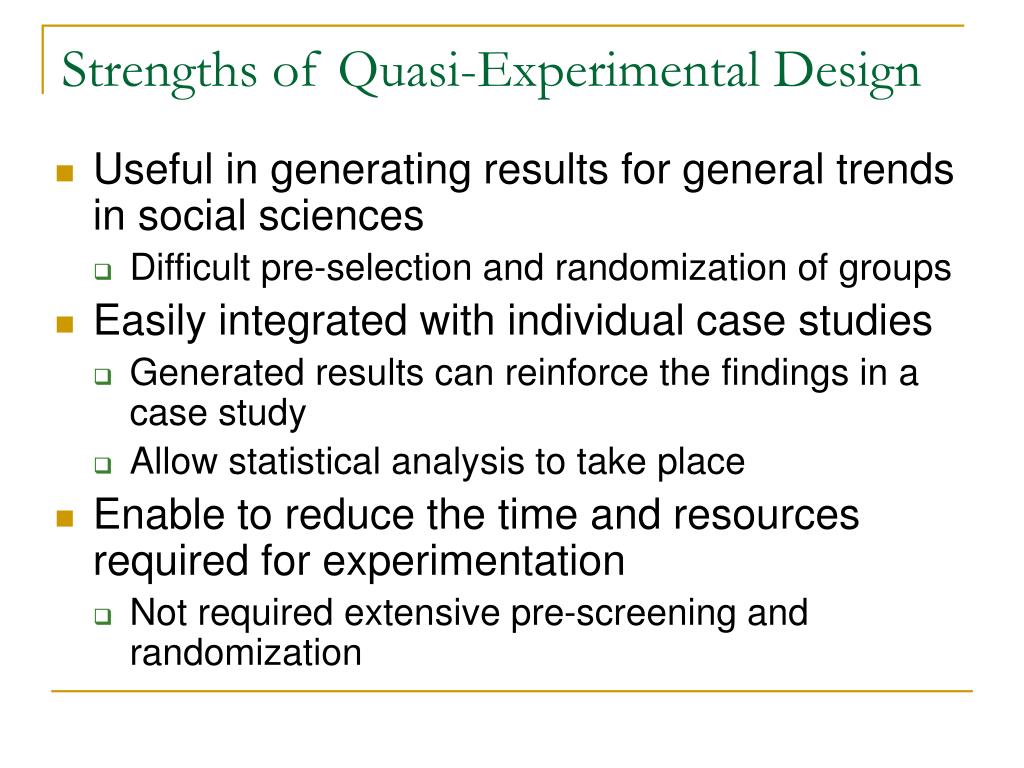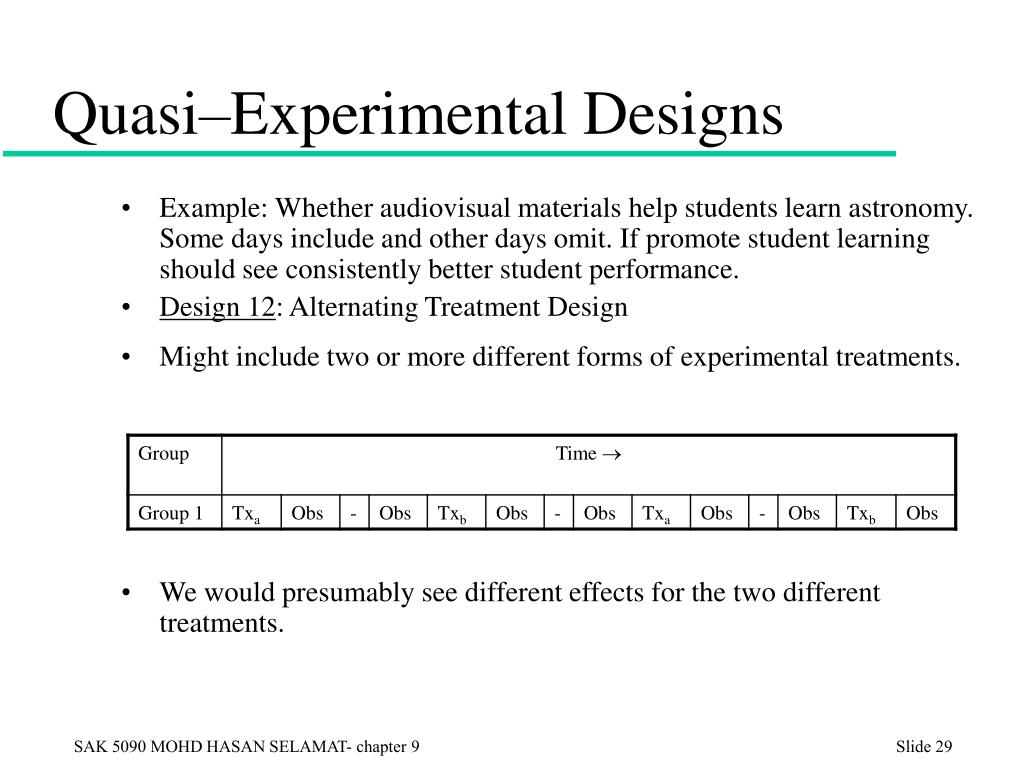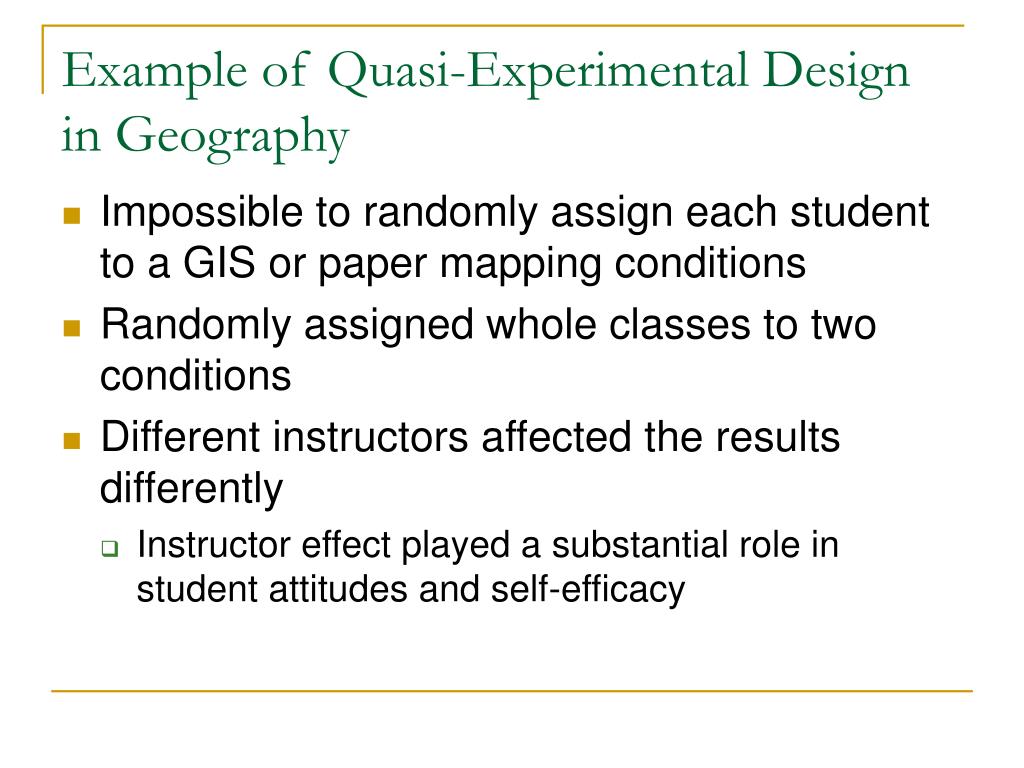Table Of Content

Theoretically, both groups are exposed to the same trends in the environment, making it plausible to decipher if the intervention had an effect. Measurement of both treatment and control conditions classically occurs pre- and post-intervention, with differential improvement between the groups attributed to the intervention. This design is popular due to its practicality, especially if data collection points can be kept to a minimum. It may be especially useful for capitalizing on naturally occurring experiments such as may occur in the context of certain policy initiatives or rollouts—specifically, rollouts in which it is plausible that a control group can be identified. For example, Kirchner and colleagues (2014) used this type of design to evaluate the integration of mental health services into primary care clinics at seven US Department of Veterans Affairs (VA) medical centers and seven matched controls. Third, given their focus, implementation RCTs are frequently cluster-randomized (i.e. with sites or clinics as the unit of randomization, and patients nested within those sites or clinics).
Types of Quasi-Experimental Designs
To conduct a quasi-experiment study like the one mentioned above, researchers can utilize QuestionPro, an advanced research platform that offers comprehensive survey and data analysis tools. With QuestionPro, researchers can design surveys to collect data, analyze results, and gain valuable insights for their quasi-experimental research. This design involves measuring the dependent variable multiple times before and after the introduction of an intervention or treatment. By comparing the trends in the dependent variable, researchers can infer the impact of the intervention. This design utilizes a cutoff point or threshold to determine which participants receive the treatment or intervention.
The Manipulation of Predictor Variables
Quasi-experimental research designs are a type of research design that is similar to experimental designs but doesn’t give full control over the independent variable(s) like true experimental designs do. Commonly used in medical informatics (a field that uses digital information to ensure better patient care), researchers generally use this design to evaluate the effectiveness of a treatment – perhaps a type of antibiotic or psychotherapy, or an educational or policy intervention. Detailed reviews have been published of variations on the basic ITS design that can be used to enhance causal inference. In particular, the addition of a control group can be particularly useful for assessing for the presence of seasonal trends and other potential time-varying confounders (52). Zombre et al (52) maintained a large number of control number of sites during the extended study period and were able to look at variations in seasonal trends as well as clinic-level characteristics, such as workforce density and sustainability. In addition to including a control group, several analysis phase strategies can be employed to strengthen causal inference including adjustment for time varying confounders and accounting for auto correlation.
External validity

Something could occur at one of the schools but not the other (e.g., a student drug overdose), so students at the first school would be affected by it while students at the other school would not. In a stepped wedge, all participants receive the intervention, but are assigned to the timing of the intervention in a staggered fashion (Betran et al., 2018; Brown and Lilford, 2006; Hussey and Hughes, 2007), typically at the site or cluster level. Stepped wedge designs have their analytic roots in balanced incomplete block designs, in which all pairs of treatments occur an equal number of times within each block (Hanani, 1961). Traditionally, all sites in stepped wedge trials have outcome measures assessed at all time points, thus allowing sites that receive the intervention later in the trial to essentially serve as controls for early intervention sites. A recent special issue of the journal Trials includes more detail on these designs (Davey et al., 2015), which may be ideal for situations in which it is important for all participating patients or sites to receive the intervention during the trial. Stepped wedge trials may also be useful when resources are scarce enough that intervening at all sites at once (or even half of the sites as in a standard treatment-versus-control RCT) would not be feasible.
Open doors by fair means: Study protocol for a 3-year prospective controlled study with a quasi-experimental design ... - BMC Psychiatry
Open doors by fair means: Study protocol for a 3-year prospective controlled study with a quasi-experimental design ....
Posted: Tue, 14 May 2019 07:00:00 GMT [source]
Discontinuity in regression
Initially all clusters (or individuals) are unexposed to the intervention, and then at regular intervals, selected clusters cross over (or ‘step’) into a time period where they receive the intervention [Figure 3 here]. All clusters receive the intervention by the last time interval (although not all individuals within clusters necessarily receive the intervention). Data is collected on all clusters such that they each contribute data during both control and intervention time periods. The order in which clusters receive the intervention can be assigned randomly or using some other approach when randomization is not possible. For example, in settings with geographically remote or difficult-to-access populations, a non-random order can maximize efficiency with respect to logistical considerations.
However, QEDs are often conducted by teams with strong interests in adapting the intervention or ‘learning by doing’, which can limit interpretation of findings if not planned into the design. As done in the study by Bailet et al (3), the investigators refined intervention, based on year 1 data, and then applied in years 2–3, at this later time collecting additional data on training and measurement fidelity. This phasing aspect of implementation generates a tension between protocolizing interventions and adapting them as they go along. When this is the case, additional designs for the intervention roll-out, such as adaptive or hybrid designs can also be considered. Table 1 summarizes the main QEDs that have been used for prospective evaluation of health intervention in real-world settings; pre-post designs with a non-equivalent control group, interrupted time series and stepped wedge designs.
Characterize fidelity and measures of implementation processes
At this design stage, the first step at improving internal validity would be focused on selection of a non-equivalent control group(s) for which some balance in the distribution of known risk factors is established. This can be challenging as there may not be adequate information available to determine how ‘equivalent’ the comparison group is regarding relevant covariates. In a classic 1952 article, researcher Hans Eysenck pointed out the shortcomings of the simple pretest-posttest design for evaluating the effectiveness of psychotherapy.
What are quasi-experimental research designs?
This design is the weakest of the quasi-experimental designs that are discussed in this article. Without any pretest observations or a control group, there are multiple threats to internal validity. Unfortunately, this study design is often used in medical informatics when new software is introduced since it may be difficult to have pretest measurements due to time, technical, or cost constraints.
Unlike traditional experiments, where researchers randomly assign participants to groups, studies work with real-world constraints, employing non-random criteria for group allocation. This flexibility makes it a practical choice for exploring complex scenarios where strict experimental controls aren’t feasible or ethical. A quasi-experimental design is a non-randomized study design used to evaluate the effect of an intervention.
The counterbalanced design is a within-participants design, where the order of the intervention is varied (e.g., one group is given software A followed by software B and another group is given software B followed by software A). The counterbalanced design is typically used when the available sample size is small, thus preventing the use of randomization. This design also allows investigators to study the potential effect of ordering of the informatics intervention.
(PDF) Examining the effectiveness of Technology use by Educators to improve students' Test Scores: A Quasi ... - ResearchGate
(PDF) Examining the effectiveness of Technology use by Educators to improve students' Test Scores: A Quasi ....
Posted: Sat, 06 Jun 2020 04:44:50 GMT [source]
This method is used to compare the outcomes of participants who fall on either side of a predetermined cutoff point. This method can help researchers determine whether an intervention had a significant impact on the target population. This design involves measuring the dependent variable(s) before and after an intervention or event, but without a control group. This design can be useful for determining whether the intervention or event had an effect, but it does not allow for control over other factors that may have influenced the outcomes. The authors administered a 50-question survey to participants and non-participants within 72 hours of the program start (pre-survey) and end (post-survey). The survey questions assessed financial knowledge, financial satisfaction, money beliefs, and money behaviors.

Researchers can then examine the long-term effects of these two groups of kids to determine the effect of attending certain schools. This information can be applied to increase the chances of students being enrolled in these high schools. We present a decision ‘map’ approach based on a Figure 5 to assist in considering decisions in selecting among QEDs and for which features you can pay particular attention to in the design [Figure 5 here]. Below are listed a few tools and online guides that can help you start your Quasi-experimental research.
For example, a research study shows that a new curriculum improved reading comprehension of third-grade children in Iowa. To assess the study's external validity, you would ask whether this new curriculum would also be effective with third graders in New York or with children in other elementary grades. This page includes an explanation of the types, key components, validity, ethics, and advantages and disadvantages of experimental design.
The comparison group consisted of non-participants identified by employers and received a financial education booklet in lieu of classes. The comparison group consisted of 56 employees, 7 from Company A and 49 from Company B. The study sample was predominantly female, and a plurality of employees had incomes between $38,521 and $101,582. However, the comparison group members had a lower percentage of bachelor’s degree recipients than the program group. Some common types of quasi-experimental designs are regression discontinuity, nonequivalent groups design, and natural experiments. These examples demonstrate how quasi-experimental designs can be applied in real-world settings to assess the impact of interventions or changes, despite the absence of randomization. Much like an actual experiment, quasi-experimental research tries to demonstrate a cause-and-effect link between a dependent and an independent variable.
In this paper we present three important QEDs and variants nested within them that can increase internal validity while also improving external validity considerations, and present case studies employing these techniques. While the basic ITS design has important strengths, the key threat to internal validity is the possibility that factors other than the intervention are affecting the observed changes in outcome level or trend. Changes over time in factors such as the quality of care, data collection and recording, and population characteristics may not be fully accounted for by the pre-intervention trend. Similarly, the pre-intervention time period, particularly when short, may not capture seasonal changes in an outcome. But at the same time there is a control group that is given a pretest, does not receive the treatment, and then is given a posttest. The question, then, is not simply whether participants who receive the treatment improve but whether they improve more than participants who do not receive the treatment.
Matching can be based on demographic and other important factors (e.g. measures of health care access or time-period). A true experiment would, for example, randomly assign children to a scholarship, in order to control for all other variables. Quasi-experiments are commonly used in social sciences, public health, education, and policy analysis, especially when it is not practical or reasonable to randomize study participants to the treatment condition.

No comments:
Post a Comment